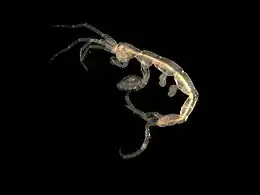Caprellidira
Caprellidira is a parvorder of marine crustaceans of the infraorder Corophiida. The group includes skeleton shrimps (Caprellidae) and whale lice (Cyamidae).
| Caprellidira | |
|---|---|
 | |
| Pariambus typicus | |
| Scientific classification | |
| Kingdom: | Animalia |
| Phylum: | Arthropoda |
| Subphylum: | Crustacea |
| Class: | Malacostraca |
| Superorder: | Peracarida |
| Order: | Amphipoda |
| Suborder: | Senticaudata |
| Infraorder: | Corophiida |
| Parvorder: | Caprellidira Leach, 1814 [1] |
| Families | |
|
See text | |
Fifteen families are currently recognised in the group. They are grouped into seven superfamilies.[2][3][4]
- Superfamily Aetiopedesoidea Myers & Lowry, 2003
- Aetiopedesidae Myers & Lowry, 2003
- Paragammaropsidae Myers & Lowry, 2003
- Superfamily Caprelloidea Leach, 1814
- Caprellidae Leach, 1814 - Skeleton shrimps
- Caprogammaridae Kudrjaschov & Vassilenko, 1966
- Cyamidae Rafinesque, 1815 - Whale lice
- Dulichiidae Laubitz, 1983
- Podoceridae Leach, 1814
- Superfamily Isaeoidea Dana, 1853
- Isaeidae Dana, 1853
- Superfamily Microprotopoidea Myers & Lowry, 2003
- Microprotopidae Myers & Lowry, 2003
- Superfamily Neomegamphopoidea Myers, 1981
- Neomegamphopidae Myers, 1981
- Priscomilitariidae Hirayama, 1988
- Superfamily Photoidea Boeck, 1871
- Ischyroceridae Stebbing, 1899
- Kamakidae Myers & Lowry, 2003
- Photidae Boeck, 1871
- Superfamily Rakirooidea Myers & Lowry, 2003
- Rakiroidae Myers & Lowry, 2003
References
- "Caprellidira Leach, 1814". Integrated Taxonomic Information System. Retrieved March 4, 2011.
- Claude De Broyer (2011). Lowry J (ed.). "Caprellida". World Amphipoda database. World Register of Marine Species. Retrieved August 31, 2011.
- Sara E. LeCroy (2007). "Appendix II: Revised Classification of the Corophiidea". An Illustrated Identification Guide to the Nearshore Marine and Estuarine Gammaridean Amphipoda of Florida. Volume 4: Families Anamixidae, Eusiridae, Hyalellidae, Hyalidae, Iphimediidae, Ischyroceridae, Lysianassidae, Megaluropidae, and Melphidippidae. Florida Department of Environmental Protection. p. 612.
- A. A. Myers & J. K. Lowry (2003). "A phylogeny and a new classification of the Corophiidea Leach, 1814 (Amphipoda)". Journal of Crustacean Biology. 23 (2): 443–485. doi:10.1651/0278-0372(2003)023[0443:APAANC]2.0.CO;2. JSTOR 1549648.
External links
 Media related to Caprellidira at Wikimedia Commons
Media related to Caprellidira at Wikimedia Commons Data related to Caprellida at Wikispecies
Data related to Caprellida at Wikispecies
This article is issued from Wikipedia. The text is licensed under Creative Commons - Attribution - Sharealike. Additional terms may apply for the media files.